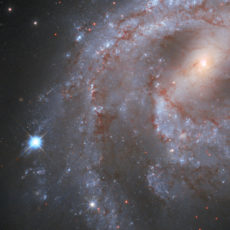
Located 150 million light-years from Earth in the constellation Leo, this image of a small galaxy captured by NASA / ESA’s Hubble Space Telescope is known as UGC 5189A, the site of a supernova explosion. This exceptionally luminous supernova event, called SN 2010jl, released at least 2.5 billion times more visible energy alone than our Sun emitted over the same time-frame across all wavelengths.

What we see in this image is a flat, misshapen galaxy, while to its right, there are plumes of shining gas and dust. The center and left side are more dim and patchy. Even after a supernova explosion fades to non-observable levels, the cosmic phenomena still intrigues astronomers, as they use it to study the environments where they occurred. Doing so provides them with valuable information since supernovae can occur for a variety of reasons, and understanding the environments in which they took place can help improve our understanding of the conditions necessary for them to be triggered.
- LEGO NASA Space Set - This adult LEGO set features the Space Shuttle Discovery and the Hubble Space Telescope from NASA’s 1990 STS-31 mission,...
- Solar System Exploration - Unlock the mysteries of our solar system with this engaging 2,354-piece project, packed with authentic details and...
- Shuttle Features Galore - The space shuttle model has an opening payload bay, retractable landing gear, opening cockpit, moving elevons, space arm,...
To this end, UGC 5189A has been observed many times by Hubble since 2010. This image is from data collected in three of the latest Hubble studies of UGC 5189A, which also examined several other relatively nearby galaxies that recently hosted supernovae — ‘relatively nearby’, in this context, meaning roughly 100 million light years away,” said the ESA.
[Source]










